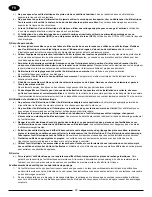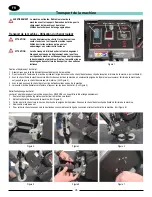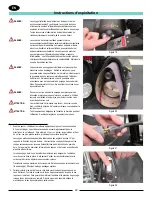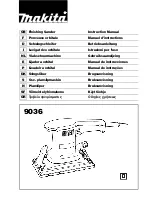
14
Sanding Cuts & Sandpaper
Chatter Wave Prevention
Initial Cut
The purpose of the initial cut is to remove old finish and gross imperfections on the floor surface. The sanding equipment should be adjusted to
heavy sanding pressure setting and a coarse abrasive belt should be used. If the surface is severely damaged by deep scratches, preexisting dwell
marks, uneven planks, etc., it may be necessary to sand across or diagonally to the grain to restore evenness to the surface. If these conditions are
not present, the initial cut should be done in the direction of the grain.
If glazing, loading, or burning takes place immediately into an initial cut, select a coarser abrasive. If this should occur during an initial cut, the
abrasive has dulled and must be replaced.
Final Cuts
The purpose of a finishing cut is to remove the scratches produced during the initial cut. Use a fine (60 - 80 grit) grain abrasive and a reduced
sanding pressure setting.
If the surface remains rough after a finishing cut, it may be necessary to use an even finer grain of abrasive (80 - 100 grit). Care should be taken in
selecting the grit size of the abrasive. A very fine grain will close the pores on a wood floor making admission of a stain difficult.
If glazing or burning should occur immediately into a finishing cut, reduce the sanding pressure. If it should occur during a finishing cut, the abrasive
has dulled and must be replaced.
American Sanders floor sanders are designed and manufactured to the most rigid
tolerances. However, after a finishing cut it is possible to see “chatter” or “waves”.
For flattest results, finish the floor with a rotating horizontal sander, such as the American
Sanders Epoch HD.
To minimize chatter when using a belt or drum sander the following steps should be taken:
1. DRUM MARKS...are caused by the operator lowering the drum to the floor without
forward traverse. These marks should be removed by cutting at a 45 degree angle to
the mark. Cutting at the mark while maintaining the same path will only increase the
mark depth and width. (See figure 35)
2. UNEVEN WALKING PACE...can leave lengthy “waves”. The machine cuts more
material during the slower pace. Pay particular attention to a steady even pace.
3. EXCESSIVE LIGHT CUTS...may reveal high spots on the paper drum and cause
chatter. Take a heavier cut and increase the pace.
Figure 35
PROPER CARE OF YOUR MACHINE CAN MINIMIZE CHATTER AND WAVES.
1. POLY V-BELTS...can cause vibration and chatter if they are of low quality. Use only belts specified by American Sanders.
2. TRUCK AND CASTER WHEELS...with flat spots, out-of-roundness, or debris adhered to their surface can cause “waves” or a “chatter effect”. Always clean
and inspect all wheels before starting to sand and before the finish cut. Replace or true the wheels if found to be out-of-round. Never allow the sander to
stand on hard surfaces for lengthy periods of time.
3. DUST PICK-UP SHOES...may need to be adjusted for different materials that are to be sanded. An improperly adjusted shoe will leave trailing debris that will
be run over by the wheels and cause “random waves”.
4. CONTACT WHEELS (DRUMS)...may be out-of-round and cause “chatter”. Contact your American Sanders dealer for assistance to true or replace the drum.
5. Bearings...in the motor, drum, or fan system may become worn and induce vibration which could cause “chatter”.
6. Upper roller...If worn or damaged, can cause chatter marks. Check upper roller before each job.
7. Worn or dull abrasive...Can cause chatter marks. Change abrasive belt regularly.
NOTE: American Sanders is not responsible for rework of floors that are unacceptable to the customer. It is your responsibility to insure your equipment is in proper
operating order, and that you use the right machine for the job.
4. DEBRIS... lodged between the paper and the drum will leave chatter. On a belt sander, debris may be adhered to the drum. Insure the drum is clean and
free of debris before placing the paper.
5. ABRASIVE QUALITY...may vary. Belt seams can be thicker on low quality paper and cause chatter. Use only American Sanders specified sandpaper.
Store abrasive according to manufacturer’s recommendation.
EN
-34-
Clarke
®
American Sanders Manual del operador (ES) - Floorcrafter
ES
ESPAÑOL
Figura
14
Cómo evitar marcas de
vibraciones y ondulaciones
Las máquinas de Clarke Sanders están diseñadas y fabricadas con las
tolerancias más estrictas. Sin embargo, después de un corte de acabado, es
posible ver marcas de vibraciones y ondulaciones.
La forma más segura para eliminar las marcas de vibraciones es realizar el
acabado del piso con una lijadora giratoria horizontal, tal como la lijadora 16
de Clarke.
Para minimizar las marcas de vibraciones cuando se utiliza una lijadora de
correa o tambor, deberá seguir los siguientes pasos:
1. MARCAS DE TAMBOR...se producen cuando el operador baja el
tambor al piso sin desplazarse hacia delante. Estas marcas deben
eliminarse cortando en un ángulo de 45 grados respecto a la marca.
Cortar en el lugar de la marca mientras se mantiene el mismo recor-
rido solamente incrementará la profundidad y la anchura de la marca.
(Consulte la figura 14)
2. ESPACIO DE RECORRIDO IRREGULAR...puede dejar “ondulaciones”
prolongadas. La máquina corta más material durante el ritmo más
lento. Preste especial atención para mantener un ritmo constante y
uniforme.
3. CORTES LIGEROS EXCESIVOS...pueden revelar grandes manchas
en la rueda de papel/contacto y causar marcas de vibraciones. Tome
un corte más pesado e incremente el ritmo.
4. LOS RESIDUOS...alojados entre el papel y el tambor dejarán marcas
de vibraciones. En una lijadora de correa, los residuos pueden
adherirse al tambor. Asegúrese de que el tambor esté limpio y libre de
residuos antes de colocar el papel.
5. LA CALIDAD DEL ABRASIVO...puede variar. Las costuras de la
correa pueden ser más gruesas en papel de poca calidad y causar
marcas de vibraciones. Utilice únicamente papel de lija especificado
por Clarke. Almacene el abrasivo de acuerdo con las recomenda-
ciones del fabricante.
EL CUIDADO ADECUADO DE SU MÁQUINA PUEDE MINIMIZAR MARCAS
DE VIBRACIONES Y ONDULACIONES.
1. LAS CORREAS EN V...pueden causar marcas de vibraciones si son
de poca calidad. Utilice únicamente correas especificadas por Clarke.
2. LAS RUEDAS DE CAMIÓN Y ROLDANAS PIVOTANTES...con
partes planas, sin redondez o con residuos adheridos a su superficie
pueden causar efectos vibratorios o ondulatorios. Limpie e inspec-
cione siempre todas las ruedas antes de comenzar a lijar y antes del
corte de acabado. Reemplace o corrija las ruedas en caso de que
no presenten redondez. Nunca permita que la lijadora repose sobre
superficies duras durante períodos de tiempo prolongados.
3. LAS ZAPATAS DE RECOLECCIÓN DE POLVO...pueden necesitar un
ajuste especial de acuerdo con los diferentes materiales que se van a
lijar. Una zapata que no esté correctamente ajustada dejará residuos
en su camino sobre los que pasarán las ruedas, pudiendo provocar
“ondas aleatorias”.
4. LAS RUEDAS DE CONTACTO (TAMBORES)...pueden
no presentar redondez y causar marcas de vibraciones.
Póngase en contacto con su distribuidor de Clarke para
solicitar asistencia a la hora de corregir o cambiar el
tambor.
5. LOS COJINETES...en el motor, el tambor o el sistema
de ventilación pueden desgastarse y producir marcas de
vibraciones.
6. LAS POLEAS...que estén dañadas o desgastadas en
exceso pueden producir marcas de vibraciones. Póngase
en contacto con un distribuidor de Clarke para obtener
asistencia.
7. La TENSIÓN DEL PAPEL DE LIJA...debe liberarse siem-
pre cuando la máquina permanezca apagada durante
10 minutos o un período más prolongado para evitar la
compresión del tambor.
NOTA: Clarke no es responsable del trabajo de
reparación de los pisos que sean inaceptables al
cliente. Es su responsabilidad asegurarse de que su
equipo esté en buenas condiciones operativas y de
que usted utiliza la máquina adecuada para realizar
el trabajo.
Summary of Contents for 07236A
Page 1: ...Belt Sander Legend Operator s Manual...
Page 2: ...2...
Page 20: ...20...
Page 39: ...39 Wiring Diagram...
Page 64: ...64 Transport Dolly Assembly RF083000 022421 1 3 4 2 8 5 7 6 TRANSPORT DOLLY ASSEMBLY...
Page 68: ...68...
Page 70: ...70...
Page 71: ...71...















































